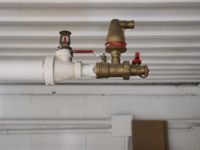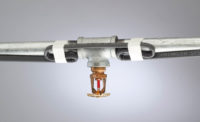As concerns continue to grow about water shortages in many parts of the United States, municipalities and facility owners continue to search for ways to better manage their water resources.
Water storage for fire suppression systems is one specific application where mechanical and fire protection engineers across the country are searching for reliable, cost-effective storage options to hold thousands of gallons of water.
Historically, fiberglass underground storage tanks have been used in the petroleum industry to safely store motor fuels and other petroleum products at thousands of retail, government and commercial fueling facilities throughout North America. The petroleum industry is highly regulated and most customers will consider only tanks meeting third-party listing standards with proven records of reliability. Designers of fire protection systems can confidently select a fiberglass water tank installed above or below grade based on decades of use storing hazardous and flammable liquids.
Specifying engineers typically have few choices when it comes to materials of construction for water storage tanks. Selecting the proper water tank is an important long-term decision.
Material considerations
Whether used in above ground or underground water tank applications, fiberglass offers the full range of performance benefits a tank designer would look for: a strong structural design, yet lightweight, easy to install, corrosion-resistant and competitively priced with other options.
As a material, fiber reinforced thermoset resin composites (fiberglass or FRP) have been used for decades in highly corrosive environments, not just for storage tanks but also piping and in handling equipment such as ducts and exhaust stacks.
As one measure of their structurally strong design, fiberglass underground tanks are designed for H-20 loading conditions, making them ideal for installation in parking lots and high-traffic locations.
• Fiberglass tanks have a long history of use in applications where watertight design integrity is critical, including extensive use in the storage of motor fuels. Leak-free performance is essential when it comes to fire protection water storage.
• Installation steps and costs are minimized by the lightweight nature of fiberglass since expensive heavy-lifting equipment generally is not necessary. This also is an important consideration when tank installation sites are difficult to access.
• Large capacity tanks, up to 60,000 gal. sizes generally required in fire protection systems, are factory-manufactured products that provide superior quality control processes vs. fabricating a tank on site where it is subject to varying weather conditions and manufacturing controls.
• A fiberglass tank can be designed for dual-purpose use, with a common example being fire protection standby as well as potable water. A fiberglass tank can be ordered with a National Sanitation Foundation listing for potable applications.
Fiberglass vs. concrete
Concrete is a material that has been used in storage tank construction for decades, both above ground and underground models. As a material of construction, it presents certain limitations.
• Concrete tanks are available in factory precast models and in the case of capacities greater than 4,000 gal., usually formed and constructed in the field, not the preferred factory-controlled manufacturing environment.
A one-piece, factory-manufactured fiberglass tank installs in much less time, saving money.
• Concrete is a very heavy material that limits the ability to easily ship and handle at jobsites while often adding to the expense of installation.
• While concrete is a strong material, the flat-tank top design of a buried concrete tank usually is not rated for traffic load conditions, requiring a design upgrade which adds to the cost.
• Concrete can be subject to aggressive corrosive attacks, often requiring an expensive liner as a solution to protect against this vulnerability to corrosion. Cracking of the concrete generally exposes the steel reinforcement to corrosion, compromising the structure.
• Many designers have concerns about concrete tanks cracking and leaking. Water tanks used in a fire protection system must have a reliable watertight design, providing the owner with confidence that water supplies will be available when needed.
Fiberglass vs. steel
As with concrete, steel has been used to construct aboveground and underground storage tanks for decades. Nonetheless, steel presents certain disadvantages when used to fabricate water storage tanks.
• One of the significant advantages fiberglass has compared to steel storage tanks is metal can’t match the rust- and corrosion-resistance of composites. With underground storage tanks, corrosion is a major concern. To address corrosion vulnerability, steel tanks are often internally and externally lined or coated, which not only adds to the cost, but also presents long-term maintenance concerns.
• Weight is another benefit to fiberglass tanks when compared to steel tanks. When comparing fiberglass and steel storage tanks, steel can weigh as much as four times that of a fiberglass tank, which generally adds to the installation cost and presents limitations with hard-to-access sites.
Fiberglass vs. polyethylene
Polyethylene does not have the long history of use in storage tank construction that steel or concrete materials do, but it does provide greater corrosion-resistant properties. Nonetheless, there are other limitations when compared to fiberglass.
• Underground fiberglass tanks don’t have the many limitations usually placed on poly tanks with regard to common installation conditions such as groundwater table, burial depths and traffic loads.
• Given structural design considerations, poly tanks are generally limited in capacity. For example, underground tank models usually are limited to much smaller capacities than what is required for typical fire protection tank installations, making it necessary to manifold together many small tanks to get the needed storage capacity. This adds cost and is less desirable than fewer large tanks.
In the field
Fiberglass storage tanks have been utilized in standalone and supplemental water supply applications for fire protection for many years. Here are examples of just a few projects that incorporated fiberglass tanks because of the benefits they offer over other storage tank solutions.
A housing development in a remote area of the Rocky Mountains required a standalone water supply for both potable water and fire protection. Underground fiberglass storage tanks were selected because of concerns about freezing water with an aboveground steel tank system.
In addition, the installation site was difficult to access with the additional equipment needed to handle the heavier weight of steel tanks. Fiberglass tanks can be lifted off the semitrailer and put in place without expensive additional equipment.
Inadequate municipal water supply for a fire suppression system in a Northern California city required a new big-box home improvement retailer to install 240,000 gal. of alternative water supply to be used in the event of a fire. Alternative storage tank methods such as poly were considered, however, poly tanks are limited in capacity unless several tanks are connected via manifolds together, which results in additional costs.
Fiberglass storage tanks were a more economical solution for this application because the total capacity of each tank was significantly more than a poly tank, thus resulting in the need for fewer tanks. Since fiberglass tanks also are designed for H-20 traffic loads, it was an easy choice since the tanks were to be buried under the retailer’s parking lot.
Aboveground and underground fiberglass storage tanks are a proven choice for fire protection applications. Increasingly strict fire codes often require dedicated standby sources of water be available to firefighters to either supplement or replace a primary water source that is either unreliable or too distant. Also, new insurance requirements are driving the need for a dedicated, reliable source of water for fire protection needs.
These are applications where only reliable, watertight, corrosion-resistant and structurally strong vessels should be used, particularly in the case of buried tanks where leaks might go unnoticed.
Choosing an inferior tank can be risky if the water supply isn’t there when the need arises.
This article was originally titled “Fill it up” in the May 2015 print edition of pme in the Fire Protection & Design Special Section.




